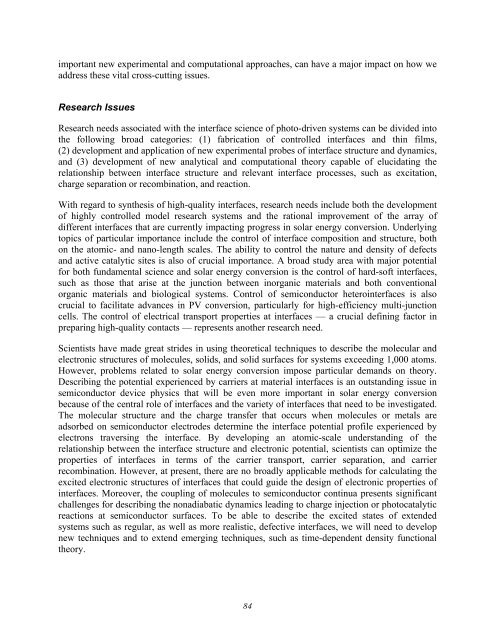Basic Research Needs for Solar Energy Utilization - Office of ...
Basic Research Needs for Solar Energy Utilization - Office of ...
Basic Research Needs for Solar Energy Utilization - Office of ...
You also want an ePaper? Increase the reach of your titles
YUMPU automatically turns print PDFs into web optimized ePapers that Google loves.
important new experimental and computational approaches, can have a major impact on how we<br />
address these vital cross-cutting issues.<br />
<strong>Research</strong> Issues<br />
<strong>Research</strong> needs associated with the interface science <strong>of</strong> photo-driven systems can be divided into<br />
the following broad categories: (1) fabrication <strong>of</strong> controlled interfaces and thin films,<br />
(2) development and application <strong>of</strong> new experimental probes <strong>of</strong> interface structure and dynamics,<br />
and (3) development <strong>of</strong> new analytical and computational theory capable <strong>of</strong> elucidating the<br />
relationship between interface structure and relevant interface processes, such as excitation,<br />
charge separation or recombination, and reaction.<br />
With regard to synthesis <strong>of</strong> high-quality interfaces, research needs include both the development<br />
<strong>of</strong> highly controlled model research systems and the rational improvement <strong>of</strong> the array <strong>of</strong><br />
different interfaces that are currently impacting progress in solar energy conversion. Underlying<br />
topics <strong>of</strong> particular importance include the control <strong>of</strong> interface composition and structure, both<br />
on the atomic- and nano-length scales. The ability to control the nature and density <strong>of</strong> defects<br />
and active catalytic sites is also <strong>of</strong> crucial importance. A broad study area with major potential<br />
<strong>for</strong> both fundamental science and solar energy conversion is the control <strong>of</strong> hard-s<strong>of</strong>t interfaces,<br />
such as those that arise at the junction between inorganic materials and both conventional<br />
organic materials and biological systems. Control <strong>of</strong> semiconductor heterointerfaces is also<br />
crucial to facilitate advances in PV conversion, particularly <strong>for</strong> high-efficiency multi-junction<br />
cells. The control <strong>of</strong> electrical transport properties at interfaces — a crucial defining factor in<br />
preparing high-quality contacts — represents another research need.<br />
Scientists have made great strides in using theoretical techniques to describe the molecular and<br />
electronic structures <strong>of</strong> molecules, solids, and solid surfaces <strong>for</strong> systems exceeding 1,000 atoms.<br />
However, problems related to solar energy conversion impose particular demands on theory.<br />
Describing the potential experienced by carriers at material interfaces is an outstanding issue in<br />
semiconductor device physics that will be even more important in solar energy conversion<br />
because <strong>of</strong> the central role <strong>of</strong> interfaces and the variety <strong>of</strong> interfaces that need to be investigated.<br />
The molecular structure and the charge transfer that occurs when molecules or metals are<br />
adsorbed on semiconductor electrodes determine the interface potential pr<strong>of</strong>ile experienced by<br />
electrons traversing the interface. By developing an atomic-scale understanding <strong>of</strong> the<br />
relationship between the interface structure and electronic potential, scientists can optimize the<br />
properties <strong>of</strong> interfaces in terms <strong>of</strong> the carrier transport, carrier separation, and carrier<br />
recombination. However, at present, there are no broadly applicable methods <strong>for</strong> calculating the<br />
excited electronic structures <strong>of</strong> interfaces that could guide the design <strong>of</strong> electronic properties <strong>of</strong><br />
interfaces. Moreover, the coupling <strong>of</strong> molecules to semiconductor continua presents significant<br />
challenges <strong>for</strong> describing the nonadiabatic dynamics leading to charge injection or photocatalytic<br />
reactions at semiconductor surfaces. To be able to describe the excited states <strong>of</strong> extended<br />
systems such as regular, as well as more realistic, defective interfaces, we will need to develop<br />
new techniques and to extend emerging techniques, such as time-dependent density functional<br />
theory.<br />
84
















